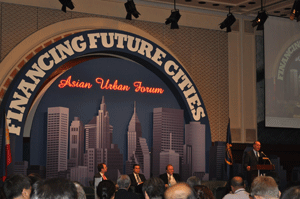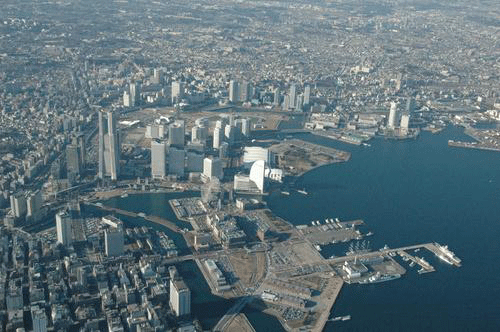[1 December 2011] -- How Asia’s cities can access investment finance to promote green, competitive and inclusive growth took centre stage at a recent three-day urban forum organised by the Asian Development Bank (ADB) on the theme, “Financing Future Cities.”
Over 500 representatives from ministries of finance and urban development, mayors, financial and urban planners, global banking institutions, consulting firms, NGOs, infrastructure companies, bilateral and multilateral development agencies and academia attended the Forum from 15-17 November 2011.
Cities Alliance was represented by Manager William Cobbett, also special invitee to a pre-forum high level urban policy roundtable on “Incentivising Asia’s Urban Future,” hosted by the City Development Initiatives for Asia (CDIA) – a regional initiative established in 2007 by the Asian Development Bank and the Government of Germany – and by Chii Akporji, Communications Specialist.

At the ADB Forum Asian cities, some already nation-sized in terms of their economy, were positioned as the new workshops of the world, accounting for more than 80 per cent of regional GDP. Photo: Chii Akporji/Cities Alliance
Asian cities, some already nation-sized in terms of their economy, were positioned as the new workshops of the world, accounting for more than 80 per cent of regional GDP. Half the world’s megacities with populations of over 10 million are in Asia, with ever accelerating urbanisation adding huge pressures on its secondary cities, which are the fastest growing. While their economic growth has lifted millions out of poverty, these cities are still home to more than two thirds of the world’s poor, many living in grim city slums and most vulnerable to the impacts of climate change and the onset of increasingly severe natural disasters.
The driving questions for the Forum, given this scenario, were: How can these cities ensure their sustainable and inclusive development, one where all Asian city dwellers can enjoy an improved quality of life with access to basic services, shelter and employment that at the same time is resilient to the impacts of climate change while still the vanguard of national and regional economic growth? What are the infrastructure investment and financing mechanisms available to them to facilitate these?
|
Fast Facts: Urbanisation in Asia -- In 2010 Asia’s population was 40 per cent urban – 1.6 billion people. Over half of Asia’s population will be urban by 2030. Another 1.4 billion people will live in Asia’s cities by 2050. -- Urbanisation is a multifaceted and complex process, the scale of which is striking. Forty-four million people are added to city populations every year, which is equivalent to 120,000 people each day. These new arrivals require the construction of more than 20,000 new dwellings, 250 km of new roads and additional infrastructure to supply more than 6 megalitres of potable water. -- With up to 80 per cent of GDP today coming from urban areas, the quality and efficiency of Asian cities will determine the region’s long-term productivity and overall stability. For example, the urban economy of India will provide 70 per cent of all new jobs and 70 per cent of GDP by 2030, with New Delhi’s economy being bigger than Malaysia’s today. -- Cities occupy only 2 per cent of the world’s land, but consume 75 per cent of its resources. Cities produce a similar percentage of waste with devastating results on the environment and the health of their citizens. -- Asian cities are likely to contribute more than half the rise in greenhouse gas emissions over the next 20 years. -- More than half of the world’s slum dwellers live in Asia – some 490 million people in 2005 according to the United Nations Human Settlements Programme (UN-HABITAT). If nothing is done that figure may rise to one billion by 2050. -- Most Asian cities do not have effective wastewater treatment systems. In the Philippines, for example, only 10 per cent of wastewater is treated, while in Indonesia the figure is 14 per cent, 4 per cent in Viet Nam, and 9 per cent in India. -- About 75 per cent of solid waste generated in urban areas is collected, according to estimates, but less than 60 per cent finds its way to a disposal site. Most Asian towns and cities use open dumps and only about 10 per cent of solid waste ends up in properly engineered and managed landfill sites. -- ADB’s urban lending, totaling over $14 billion to date, has focused primarily on infrastructure. In 2011, around 65 per cent of lending has been in urban areas. Source: ADB External Affairs |
Opening the Forum ADB President, Haruhiko Kuroda Asian said cities need to make continuous efforts to become livable, competitive, inclusive and environmentally sustainable cities: “With approximately 80 per cent of GDP today coming from urban areas, the quality and efficiency of Asia’s cities and their ability to innovate will determine the region’s long-term productivity and overall stability,” he added.
In response the ADB has developed a new Urban Operational Plan focused on three key components: Green Cities, Competitive Cities and Inclusive Cities. Achieving these qualities will require developing cutting edge, high-value added industries and services focused on regional needs, improving the quality of infrastructure, upgrading training to nurture creative talent, reducing costs to get products to market, and providing a supportive physical environment.
In his keynote address Philippine Vice President and Chair of the Housing and Urban Development Coordinating Council (HUDCC) Jejomar Binay welcomed all participants to Manila on behalf of his government. He described urbanisation as “one of the fastest growing phenomena in the world today and one of the most serious challenges confronting governments. At no other point in our history has mankind had to confront the simultaneous impact of growing population, diminishing finite and non-renewable resources, and ever-increasing destruction of the environment.” But just as cities shape the lives of their citizens, “we must make an earnest effort to so shape our cities that they become the bearers of our preferred vision of the future.”
He defined what he called “one of our more exciting interventions” on the part of the Philippine government to be the development of a National Slum Upgrading Strategy (NSUS) side by side with a national resettlement framework: “Last May, the Cities Alliance approved our Housing And Urban Development Coordinating Council’s proposal to develop such a strategy. Both the national and local governments will now undertake the relevant policies and programs for slum upgrading, under the guidelines provided by that strategy, and supported by Cities Alliance.”
Several financing institutions gave their perspectives on partnerships with cities as well as providing case studies of how cities can access investment finance. Michael Redican of Deutsche Bank, in his presentation titled, “Enabling Frameworks for Financing Competitive Cities” argued that contrary to widespread belief, investors do like to support urban interventions that result in great social benefits and outcomes, although their primary motive may be return on investment.
He provided the case study of Partnerships UK and its deployment of Regulatory Asset Base Financing for the water sector in some English cities.One of the cities showcased as exemplary of green, competitive and inclusive city is Yokohama, Japan’s second largest city, current population of 3.9 million.
City Manager for International Technical Cooperation, Toru Hashimoto provided an overview of the port city’s rise from natural and man-made disasters such as the Great Kanto earthquake of 1923 and the massive air raids from American forces during World War II to one of the world’s most livable cities exhibiting elements of smart growth, public/private partnerships, an extensive transportation network, mixed-use programming, and 24-hour nodes of activity which attract new businesses, residents, and more than 50 million visitors every year.

Like other large cities, Yokohama faced the usual issues attendant upon rapid urbanisation such as urban sprawl and unplanned housing development, financial constraints, undersupply of public services, traffic congestion, and pollution. Yokohama tackled these weaknesses by creating and implementing a series of strategic urban development projects, known as the Six Major Projects, and a variety of unique urban growth control/management mechanisms; deftly getting the involvement of the central government, the private sector, and the civil society in its strategy and planning process; and making full use of its unique assets such as ports as well as historically and architecturally important structures.
Yokohama was nominated as one of the first six Eco2 Cities by the World Bank, the others being: Curitiba, Stockholm, Singapore, Brisbane, and Auckland. Eco2 Cities are defined as cities with the right balance of ecological sustainable development and economic growth. Yokohama hosted the first Eco2 Cities international conference in October 2010 with the support of Cities Alliance and the government of Japan.
A major highlight of the Forum was the launch of the ADB publication, Competitive Cities in the 21st Century: Cluster Based Local Economic Development, co-authored by Professor Brian Roberts of the University of Canberra and the late Dr. Kae Choe of the ADB. The book advocates what it calls a City Cluster Economic Development (CCED) approach to more competitive cities, through fostering the development of industry clusters. The competitiveness of a city refers to its ability to produce and market a set of products (goods and services) that represent good value (not necessarily lowest price) in relation to comparable products of other cities.
In light of rising urbanisation and socio-economic consequences such as rising unemployment governments around the world have a vested interest in how to make their cities more competitive – attracting investment and creating jobs that help reduce poverty and unemployment. However, in striving to become more competitive there is a growing realisation that the quality of the urban environment, social systems, and employment can no longer be neglected. These factors are part of the competitiveness equation.

Based on analytical results, the creation of an economic competitiveness profile for selected urban economies, an industry cluster, and the creation of a strategic foundation that aims to generate more jobs and income opportunities are suggested.
The intended impact of the CCED approach is the creation of more job and income opportunities, in both the urban and rural areas and its rural hinterland. Singapore, Hong Kong and Bangalore are adjudged as highly competitive cities where the focus of economic development has moved away from an emphasis on low-cost infrastructure, low labor costs, and low taxes, toward highly competitive cities and industry clusters with skilled workers, advanced infrastructure, and innovation.
For the ADB the CCED approach provides a new paradigm for urban economic development – proactively supporting private sector development, promoting productivity of industry, and small and/or medium-sized enterprise (SME) clusters and fostering competitiveness of cities. The plan is that the approach can help ADB’s developing member countries target their investments based on their visions for economic growth and poverty reduction.




